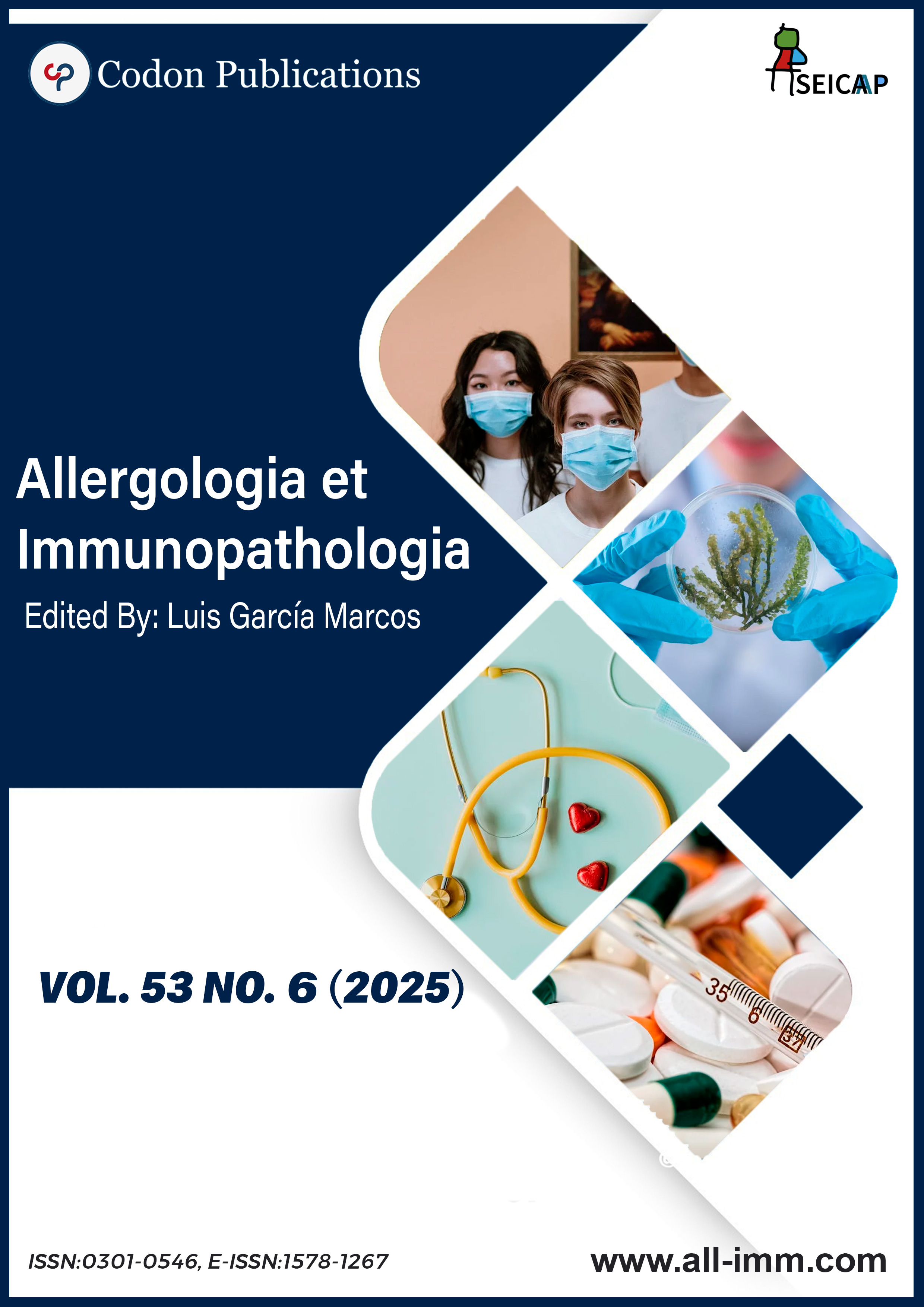Network pharmacology-guided probiotic metabolite therapy for acne vulgaris to target Cutibacterium acnes CAMP factors through Pediococcus acidilactici BCBH1 fatty acids
Main Article Content
Keywords
acne vulgaris, cutibacterium acnes, camp proteins, vaccenic acid, 4-terpineol
Abstract
Acne vulgaris is a chronic inflammatory skin disorder predominantly caused by Cutibacterium acnes and its virulence-associated CAMP (Christie–Atkins–Munch-Petersen) factors, particularly CAMP1 and CAMP2, which contribute to inflammation and bacterial survival. With increasing antibiotic resistance and concerns over microbiome disruption from conventional treatments, probiotic-derived postbiotics present a promising alternative. This study aimed to investigate the anti-acne potential of fatty acids produced by Pediococcus acidilactici BCBH1, targeting CAMP1 and CAMP2 proteins of C. acnes using a network pharmacology-guided approach. Metabolite profiling via GC-MS identified vaccenic acid as a major fatty acid metabolite (4.88 mg/L at 48 h under 10% linoleic acid stress). Virulence prediction confirmed high pathogenicity of CAMP1 (score 0.9055) and CAMP2 (score 0.9927). Molecular docking revealed strong binding affinities of vaccenic acid to CAMP1 and CAMP2 with binding energies of –9.6 kJ/mol and –9.3 kJ/mol, respectively, outperforming traditional anti-acne compound 4-terpineol (–9.0 kJ/mol and –8.7 kJ/mol). Molecular dynamics simulations further validated the stable interaction of vaccenic acid with CAMP proteins over 100 ns. Pharmacokinetic analyses indicated vaccenic acid’s favorable absorption and safety profiles with no blood–brain barrier permeability. These findings highlight vaccenic acid as a potent, microbiome-friendly therapeutic candidate for acne management. Future work should focus on experimental validation, formulation development, and combinatorial strategies to enhance clinical efficacy and safety.
References
2 Parać E, Špiljak B, Lugović-Mihić L, Bukvić Mokos Z. Acne-like eruptions: Disease features and differential diagnosis. Cosmetics. 2023;10(3):89. 10.3390/cosmetics10030089
3 Niedźwiedzka A, Micallef MP, Biazzo M, Podrini C. The role of the skin microbiome in acne: Challenges and future therapeutic opportunities. Int J Mol Sci. 2024;25(21):11422. 10.3390/ijms252111422
4 Szepietowska M, Bień B, Krajewski PK, Stefaniak AA, Matusiak Ł. Prevalence, intensity and psychosocial burden of acne itch: Two different cohorts study. J Clin Med. 2023;12(12):3997. 10.3390/jcm12123997
5 McLaughlin J, Watterson S, Layton AM, Bjourson AJ, Barnard E, McDowell A. Propionibacterium acnes and acne vulgaris: New insights from the integration of population genetic, multi-omic, biochemical and host-microbe studies. Microorganisms. 2019;7(5):128. 10.3390/microorganisms7050128
6 Mayslich C, Grange PA, Dupin N. Cutibacterium acnes as an opportunistic pathogen: An update of its virulence-associated factors. Microorganisms. 2021;9(2):303. 10.3390/microorganisms9020303
7 Keshari S, Kumar M, Balasubramaniam A, Chang TW, Tong Y, Huang CM. Prospects of acne vaccines targeting secreted virulence factors of Cutibacterium acnes. Expert Rev Vaccines. 2019;18(5):433–7. 10.1080/14760584.2019.1593830
8 Rathi SK. Acne vulgaris treatment: The current scenario. Indian J Dermatol. 2011;56(1):7–13. 10.4103/0019-5154.77543
9 Bandyopadhyay D. Topical antibacterials in dermatology. Indian J Dermatol. 2021;66(2):117–25. 10.4103/ijd.IJD_99_18
10 Suuberg A. Psychiatric and developmental effects of isotretinoin (retinoid) treatment for acne vulgaris. Curr Ther Res Clin Exp. 2019;90:27–31. 10.1016/j.curtheres.2019.01.008
11 Muteeb G, Rehman MT, Shahwan M, Aatif M. Origin of antibiotics and antibiotic resistance, and their impacts on drug development: A narrative review. Pharmaceuticals (Basel). 2023;16(11):1615. 10.3390/ph16111615
12 Kober MM, Bowe WP. The effect of probiotics on immune regulation, acne, and photoaging. Int J Womens Dermatol. 2015;1(2):85–9. 10.1016/j.ijwd.2015.02.001
13 Niu T, Jiang Y, Fan S, Yang G, Shi C, Ye L, Wang C. Antiviral effects of Pediococcus acidilactici isolated from Tibetan mushroom and comparative genomic analysis. Front Microbiol. 2023;13:1069981. 10.3389/fmicb.2022.1069981
14 Douglas EJA, Palk N, Rudolph ER, Laabei M. Anti-staphylococcal fatty acids: Mode of action, bacterial resistance and implications for therapeutic application. Microbiology (Reading). 2025;171(5):1563. 10.1099/mic.0.001563
15 De Almeida CV, Antiga E, Lulli M. Oral and topical probiotics and postbiotics in skincare and dermatological therapy: A concise review. Microorganisms. 2023;11(6):1420. 10.3390/microorganisms11061420
16 Jasra N, Naveed M, Aldalali S, Sarwar A, Yang Z, Aziz T, et al. Integrative interpretation of linoleic acid biotransformation by probiotic Pediococcus acidilactici BCB1H via metabolite profiling and enzyme interaction analysis. LWT. 2025;117664. 10.1016/j.lwt.2025.117664
17 Mayslich C, Grange PA, Castela M, Marcelin AG, Calvez V, Dupin N. Characterization of a Cutibacterium acnes camp factor 1-related peptide as a new TLR-2 modulator in in vitro and ex vivo models of inflammation. Int J Mol Sci. 2022;23(9):5065. 10.3390/ijms23095065
18 Yingnan Z, Gaoxing M, Fei P, Ning M, Su A, Hu Q, Meng W. Evaluation of active components and pharmacological activities by UPLC-Q/TOF-MS and network pharmacology in Lentinula edodes and Lyophyllum decastes. Quality Assurance and Safety of Crops & Foods, 2024; 16(4):99–123. 10.15586/qas.v16i4.1510
19 Stark JM, Coquet JM, Tibbitt CA., The role of PPAR-γ in allergic disease. Current Allergy and Asthma Reports, 2021, 21(11):8. 10.1007/s11882-021-01022-x
20 Yun XL, Zheng L, Hanpiao X, Liu L, Wenying H, Jun X, Qiaozhi Y, Zhang T, Hui Y. Decoding Hippophae rhamnoides’ action of mechanism in Sjögren’s syndrome: A network pharmacology and molecular docking study. Quality Assurance and Safety of Crops & Foods, 2023;15(1): 207–250. 10.15586/qas.v15i1.1210
21 Ibrahim SA, Ayivi RD, Zimmerman T, Siddiqui SA, Altemimi AB, Fidan H, et al. Lactic acid bacteria as antimicrobial agents: Food safety and microbial food spoilage prevention. Foods. 2021;10(12):3131. 10.3390/foods10123131
22 Batushansky A, Matsuzaki S, Newhardt MF, West MS, Griffin TM, Humphries KM. GC-MS metabolic profiling reveals fructose-2,6-bisphosphate regulates branched chain amino acid metabolism in the heart during fasting. Metabolomics. 2019;15(2):18. 10.1007/s11306-019-1478-5
23 Cobian N, Garlet A, Hidalgo-Cantabrana C, Barrangou R. Comparative Genomic Analyses and CRISPR-Cas Characterization of Cutibacterium acnes Provide Insights Into Genetic Diversity and Typing Applications. Front Microbiol. 2021;12:758749. 10.3389/fmicb.2021.758749
24 Henrissat B. A classification of glycosyl hydrolases based on amino acid sequence similarities. Biochem J. 1991;280 (Pt 2)(Pt 2):309–16. 10.1042/bj2800309
25 Mizugishi K, Inoue T, Hatayama H, Bielawski J, Pierce JS, Sato Y, et al. Sphingolipid pathway regulates innate immune responses at the fetomaternal interface during pregnancy. J Biol Chem. 2015;290(4):2053–68. 10.1074/jbc.M114.628867
26 Eichenfield LF, McFalda W, Brabec B, Siegfried E, Kwong P, McBride M, et al. Safety and efficacy of VP-102, a proprietary, drug-device combination product containing cantharidin, 0.7% (w/v), in children and adults with molluscum contagiosum: Two phase 3 randomized clinical trials. JAMA Dermatol. 2020;156(12):1315–23. 10.1001/jamadermatol.2020.3238

